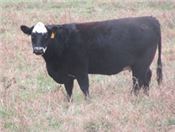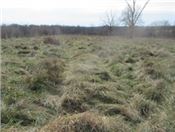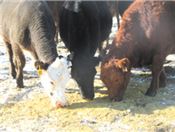MU Extension Livestock Specialist Addresses Fescue Stockpile Questions
MT. VERNON, MO.
Last week Eldon Cole, a livestock specialist with University of Missouri Extension, had two similar questions from producers about fescue stockpile’s nutrient content.
“Even though the forage involved was similar, the animals grazing it were quite different. One herd was fall calvers while the other was fleshy cows just starting to calve,” said Cole.
Each producer had stockpiled fescue remaining but was concerned about the protein level in it.
“I assured them the crude protein level was probably greater than they thought. It’s rare to have fescue stockpile test lower than 10 percent crude protein around February 1. I've even seen some hit 15 percent,” said Cole.
As for total digestible nutrients (TDN) in the fescue this time of year, Cole says he usually sees it in the low 50’s to 55. By Feb. 1, the question of TDN level or quality may be secondary to quantity.
“Each of the callers assured me there was ample forage available for the cattle to get their recommended daily dry matter intake. I would like it in the 8 to 10-inch tall range or more,” said Cole.
The requirements for dry matter intake on fall-calving cows that average Oct. 1 birth date on their calves, weighing 1200 lbs. goes down rapidly as their milk production declines and they are well into the first one-third of pregnancy. According to Cole, if body condition scores (BCS) are in the five to upper four range they should easily be meeting their protein and TDN levels with the stockpiled fescue.
“Feeding an energy supplement at this point should only be considered on first-calf heifers and old cows. Here is where sorting cows off that are needy, low, 4 BCS types so they can be supplemented without wasting the feed on fleshy, middle-aged cows,” said Cole.
Heavy springing cows that are BCS 6's may be the ones likely to benefit from extra good quality hay or 2 or 3 pounds per day of a commodity mix like soy hulls, corn gluten feed, and distillers grains.
One caller asked about creep feeding the fall calves.
“I said it’s usually more practical to creep the calves at this point than to try and feed more milk production from the cow. If you have wheat, rye or triticale pasture coming on they make an excellent creep for fall calves,” said Cole.
Alfalfa hay or even top quality haylage also can provide extra nutrition for the fall calf.
“The bottom line on supplementing stockpile fescue is it is better than you think it is if you have plenty of it. As fescue greens up in February, it even gets better with each warm day,” said Cole. “Fescue that contains toxic alkaloid levels during certain seasons is probably the least toxic now than at any other time so take advantage of it.” ∆

Dry cow with abundant stockpiled fescue.
Photos courtesy of MU Extension.

Stockpile fescue generally is higher in energy and protein than fescue hay harvested in late May and June.

Supplement feeding a commodity mix to heavy springers helps them breed back quickly.